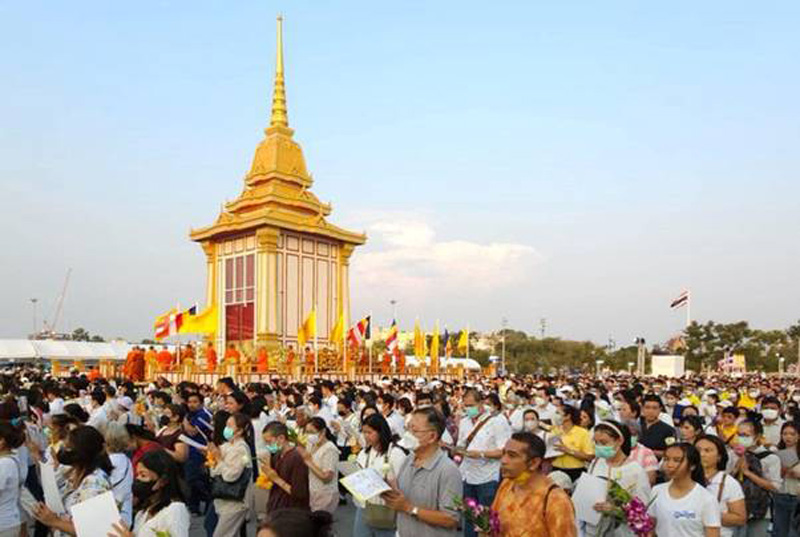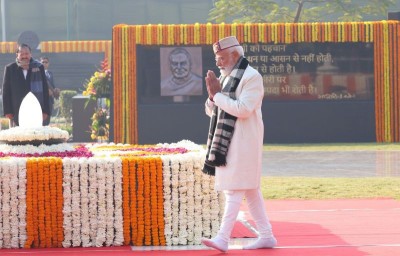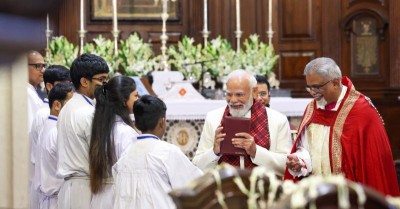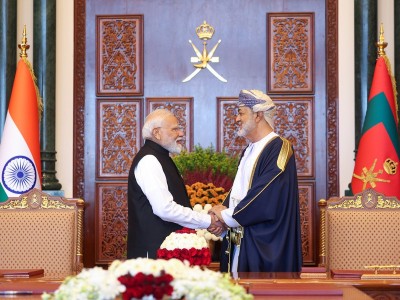 India-Thailand
India-Thailand
India’s Buddhist diplomacy in Thailand
There is a recent video on social media that shows scores of Thai citizens, including policemen, waiting patiently at Bangkok airport to see off the relics of Lord Buddha.
Such is the reverence for the Buddha in South East Asia that the 26 days display of the sacred relics of Lord Buddha, along with those of his two disciples Sariputra and Maudgalyayana, at various locations across Thailand, attracted millions of visitors.
The relics were returned to India on 19 March.
While India has used Buddhism as a foreign policy tool in the past, the intensity of such interactions has been enhanced in recent years.
The latest initiative with Thailand illustrates the strategic importance of culture and heritage within the contemporary Indian diplomatic discourse and the benefits that accrue from the pursuit of initiatives aimed at promoting cultural cooperation between nations.
India’s diplomatic policy establishment in recent decades has placed a strong emphasis on its rich culture and heritage.
Two recent examples in "relic diplomacy," where India shared the relics of Lord Buddha with Thailand and Queen St. Ketevan with Georgia can be cited as illustrations of this diplomatic outreach.
While Lord Buddha relics are more popularly known, the relics of Queen St. Ketavan, found in Goa were returned to Georgia in 2021.
More on Queen Ketevan a little later. These initiatives not only showcase India's rich cultural heritage but also serve as a powerful tool of communication and connection that helps to connect different cultures.
In India, objects like historical artifacts and other tangible remains, have crossed borders many times and come to represent the idea of "Vasudhaiva Kutumbakam" (the world is one family). This philosophy emphasizes the interconnectedness of all people. It is this basic philosophy that gives momentum to relic diplomacy and furthers Indian foreign policy in myriad ways.
Pertinently, the sacred relics of Lord Buddha, known as the Kapilavastu relics, are housed at India’s National Museum.
They are believed to be the remains of Buddha and two of his disciples, Sariputra and Maudgalayana, dating back to around the 4th-5th century BC.They were unearthed by the Archaeological Survey of India (ASI) in the 1970s in Piprahwa near Siddharthnagar in Uttar Pradesh, a site thought to be the ancient city of Kapilvastu.
These sacred relics have travelled abroad for exhibitions, having been displayed in Mongolia and Sri Lanka in the past.However, in the case of Thailand, it was the first time that the relics of Lord Buddha and his disciples were showcased together.
They were flown to Thailand on 22 February 2024, with the respect of a visiting dignitary on a special Indian Air Force plane.
(3).jpg)
These relics are considered exceptionally rare and valuable, classified under the "AA" category for antiquities and art treasures.
However, India’s Ministry of Culture made an exception and acceded to the special request from the Thai government, allowing them to be displayed in Thailand.
The special exhibition in Thailand also marked the 72nd birth year of the King Rama X, highlighting the civilizational link between India and Thailand.
These relics were put on display for public veneration in Bangkok for the first time ever, starting on 23 February.
These values, embodied by the Buddha and his disciples, are being highlighted through the exhibition of bone fragments in Bangkok's National Museum.
The exhibition is part of a long tradition of such exchanges, with India previously sending relics to Sri Lanka, Mongolia, Singapore, South Korea, and Thailand.
The exhibition then travelled across Thailand, with stops in several cities before concluding on 18 March.
The event drew a large crowd of devotees, with many lining up, early in the morning, to pay their respects.
After the month-long exhibition in Thailand, Minister of State Meenakshi Lekhi, received them at a special ceremony at Air Force Station, Palam and respectfully carried the casket containing the relics.
On this occasion she spoke about the deep cultural connection between India and Thailand, strengthened by the Buddha's timeless message.
Relic diplomacy can also be contextualised in terms of India’s Look East policy as India has actively built on the shared cultural heritage with countries in South East Asia, like those in the Association of Southeast Asian Nations (ASEAN).
Thailand is a recent example of this collaboration, signifying India's ongoing efforts to promote cultural understanding and unity. India's sharing of Buddhist relics with South East Asian nations like Vietnam earlier reflect this trend.
Another aspect of relic diplomacy is the role of the ASI in restoring historical sites in the ASEAN region. For instance, the ASI has restored historical sites in Cambodia and also uncovered treasures like Buddha’s statues.
Such initiatives strengthen the already strong foundation between India and South East Asia, aligning with their respective foreign policies of "Act East" and "Look West."
India uses its long history as a centre of spirituality and knowledge (its "Dharmic civilization") as a unique form of soft power. It promotes the exchange of ideas, cultural connections, and traditional wisdom to address modern problems.
Today, 97% of the world’s Buddhist population lives in the Asia and South East Asia, and a number of countries such as Bhutan, Myanmar, Thailand, and Sri Lanka perceive Buddhism as being intrinsic to their national values and identity.
Prime Minister Modi recently laid the foundation stone in Lumbini, Nepal of the India International Centre for Buddhist Culture and Heritage.
It aims to be a centre for Buddhist learning and attract international visitors. Designed with prayer halls, meditation areas, a library, and an exhibition hall, the Centre will showcase Buddhist teachings and history.
This project goes beyond just the building. Lumbini is part of a larger Buddhist circuit, with other important sites marking Buddha's life journey.
Another successful example of cultural diplomacy involves Georgia. In July 2021, Dr. Jaishankar, Minister of External Affairs returned the relics of the revered Queen St. Ketevan.

A symbol of faith and resilience, the Queen's remains, discovered in Goa, highlight the historical ties between India and Georgia today.
In 2017, India had shared the holy relics of Saint Queen Ketevan with Georgia for six months.
The relics hold significant historical and religious importance for Georgia. Ketevan (1560-1624) was the queen of Kakheti, a kingdom located in a region of eastern Georgia that bears the same name.
After her death at the hands of the Safavid empire, two Portuguese Augustinian monks brought her remains to the St. Augustine Chapel in Goa in 1627.
In 2017, after talks between the Indian and Georgian governments, the Ketevan relics were sent to Georgia for an exhibition for six months.
After taking the relics to different churches, they were returned in 2018.
After which, the Georgian government appealed to India to permanently transfer the Ketevan relics because of their historical and spiritual importance to Georgians. After this, India gifted one part of the Ketevan relics to Georgia. This is the power of cultural diplomacy.
Countries use cultural diplomacy to achieve specific goals, and for India, its cultural ties are linked to its political and economic interests. This raises the possibility that relic diplomacy, or showcasing religious artefacts, can be used more strategically.
As more countries engage in Buddhist diplomacy, India will face new challenges, such as competition from countries like China and Pakistan.
India's cultural diplomacy should remain confident and focus on its unique strengths.With Prime Minister Modi in line to win the next General Election, in June 2024, the “Buddhist” aspect of Indian public diplomacy is likely to be maintained and intensified.
Support Our Journalism
We cannot do without you.. your contribution supports unbiased journalism
IBNS is not driven by any ism- not wokeism, not racism, not skewed secularism, not hyper right-wing or left liberal ideals, nor by any hardline religious beliefs or hyper nationalism. We want to serve you good old objective news, as they are. We do not judge or preach. We let people decide for themselves. We only try to present factual and well-sourced news.







